What’s Up?
I hope that I am doing well somewhere in Namibia. If all goes well and I stay out of trouble, I will be back in the office late on the afternoon of Friday, April 29.
The Streak
Today’s blog post marks 172 days in a row with a new educational blog post… As always-–and folks have been doing a really great job recently–-please remember to use our B&H links for your major gear purchases. For best results use one of our many product-specific links; after clicking on one of those you can continue shopping with all subsequent purchases invisibly tracked to BAA. Your doing so is always greatly appreciated. Please remember: web orders only. Please remember that if you are shopping for items that we carry in the BAA Online Store (as noted in red at the close of this post below) we would appreciate your business.
|
This image was created at Fort DeSoto in late April with the the Induro GIT 304L/Mongoose M3.6-mounted Canon EF 600mm f/4L IS II USM lens and the fast, rugged Canon EOS-1D X. ISO 1600. Evaluative metering +1 2/3 stops: 1/1250 sec. at f/4. A single AF point two to the right of the center AF point fell on the neck of the bird on our right and was active at the moment of exposure. AI Servo/Surround/Rear Focus AF. Click here to see the latest version of the Rear Focus Tutorial. Click on the image to see a larger version. Sandwich Terns/mated pair hanging out |
Love is in the Air
Love is in the air at Fort DeSoto in spring. Note the pink tinge on the breasts of these two Sandwich Terns. I went with a high ISO and a relatively fast shutter speeds in hopes that they would either take off or copulate.
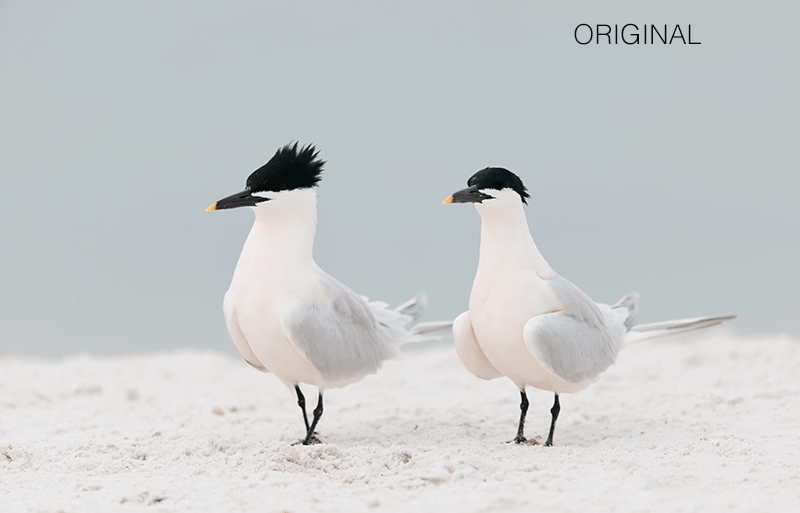
|
Too Much, Not Enough, Or Just Right?
What do you think of the beach clean-up? I used my usual cadre of tools including the Clone Stamp Tool, the Patch Tool, and the Spot Healing Brush. A small, warped Quick Mask refined with a regular Layer Mask was used to cover the mess by the right hand bird’s feet.
Digital Basics
Everything that I did to optimize today’s featured image is covered in detail in my Digital Basics File–written in my easy-to-follow, easy-to-understand style. Are you tired of making your images look worse in Photoshop? Digital Basics File is an instructional PDF that is sent via e-mail. It includes my complete digital workflow, dozens of great Photoshop tips, details on using all of my image clean-up tools, the use of Contrast Masks, several different ways of expanding and filling in canvas, all of my time-saving Keyboard Shortcuts, Quick Masking, Layer Masking, and NIK Color Efex Pro basics, Digital Eye Doctor techniques, using Gaussian Blurs, Dodge and Burn, a variety of ways to make selections, how to create time-saving actions, the Surface Blur settings that I use to smooth background noise, Divide and Conquer, protective cloning on a layer, and tons more.
APTATS I & II
Learn the details of advanced Quick Masking techniques in APTATS I. Learn Advanced Layer Masking Techniques in APTATS I. Mention this blog post and apply a $5 discount to either with phone orders only. Buy both APTATS I and APTATS II and we will be glad to apply at $15 discount with phone orders. Please call Jim or Jennifer weekdays at 863-221-2372 to take advantage of this special offer. You can find the same deal in the BAA Online Store here.
|
You can order your copy of “The Photographers’ Guide to Canon Digital Photo Professional 4.0” (aka the DPP 4 Raw Conversion eGuide) by Arash Hazeghi and Arthur Morris by clicking here. |
The DPP 4 eGuide (PDF)
The RAW file for today’s image was of course converted in DPP 4. Learn how and why I and many other discerning photographers choose and use only DPP 4 to convert their Canon RAW files in the DPP 4 RAW Conversion Guide by Arash Hazeghi and yours truly. The latest version supports all of the newer Canon camera bodies and several older models including the EOS-7D and the EOS-1D Mark IV. The DPP IV Guide is the ideal companion to the 7D Mark II User’s Guide, a runaway best seller.
The DPP 4 eGuide (PDF) Updated for 1D Mark IV and the original 7D
The DPP 4 eGuide was recently updated to include the luminance and chrominance noise reduction values for both the 1D Mark IV and the original 7D. If you purchased your copy from BAA please e-mail Jim and request the DPP 4 1d IV/7D update. Please be sure to cut and paste page 1 into your e-mail as proof of purchase.
DPP 4 Kudos
From Richard Gollard via e-mail:
I have been doing tons of studying the books and PDFs that I have purchased from BIRDS AS ART. And I have to say that after reading the DPP 4 conversion guide that you did with Arash Hazeghi I tried DPP 4 and was blown away with the difference from the conversions that I made with Adobe Photoshop and Lightroom. Thanks for the consistently great information.
|
DeSoto in spring is rife with tame and attractive birds. From upper left clockwise to center: breeding plumage Dunlin, dark morph breeding plumage Reddish Egret displaying, breeding plumage Laughing Gull/front end vertical portrait, breeding plumage Laughing Gull with prey item, Laughing Gull on head of Brown Pelican, screaming Royal Tern in breeding plumage, Royal Terns/pre-copulatory stand, Laughing Gulls copulating, breeding plumage Laughing Gull/tight horizontal portrait, Sandwich Tern with fish, and a really rare one, White-rumped Sandpiper in breeding plumage, photographed at DeSoto in early May. |
Fort DeSoto IPT: May 10-13, 2016. 3 1/2 DAYS: $1399. Limit: 10/Openings: 1.
Meet and Greet at 3pm on Tuesday May 10.
Fort DeSoto is one of the rare locations that might offer great bird photography 365 days a year. It shines in spring. There will Lots of tame birds including breeding plumage Laughing Gull and Royal and Sandwich Terns. With luck, we will get to photograph all of these species courting and copulating. There will be American Oystercatcher and Marbled Godwit plus sandpipers and plovers, some in full breeding plumage. Black-bellied Plover and Red Knot in stunning breeding plumage are possible. There will be lots of wading birds including Great and Snowy Egrets, both color morphs of Reddish Egret, Great Blue, Tricolored and Little Blue Heron, Yellow-crowned Night-Heron, and killer breeding plumage White Ibis. Roseate Spoonbill and Wood Stork are possible and likely. We should have lots of good flight photography with the gulls and terns and with Brown Pelican. Nesting Least Tern and nesting Wilson’s Plover are possible.
We will, weather permitting, enjoy 7 shooting sessions. Our first afternoon session will follow the meet and greet on Tuesday May 10. For the next three days we will have two daily photo sessions. We will be on the beach early and be at lunch (included) by 11am. At lunch we will review my images–folks learn a ton watching me choose my keepers and deletes–why keep this one and delete that one? If you opt to bring your laptop, we will be glad take a look at a few of your best images from the morning session. We will process an image or two in Photoshop after converting them in DPP. Our lunch learning session will be followed by a break that for me will include Instructor Nap Time. Afternoon sessions will generally run from 4:30pm till sunset. We photograph until sunset on the last day, Friday the 13th… Please note that this is a get-your-feet and get-your-butt wet and sandy IPT. And that you can actually do the whole IPT with a 300 f/2.8L IS, a 400 f/4 ID DO lens with both TCs, or the equivalent Nikon gear. I will likely be using my new 500 II as my big glass and have my 100-400 II on my shoulder.
|
DeSoto in spring is rife with tame and attractive birds. From upper left clockwise to center: Laughing Gull in flight, adult Yellow-crowned Night-Heron, copulating Sandwich Terns, Roseate Spoonbill, Great Egret with reflection, Short-billed Dowitcher in breeding plumage, American Oystercatcher, breeding plumage Royal Tern, white morph Reddish Egret, and Snowy Egret marsh habitat shot. |
What You Will Learn
You will learn to approach free and wild birds without disturbing them, to understand and predict bird behavior, to identify many species of shorebirds, to spot the good situations, to understand the effects of sky and wind conditions on bird photography, to choose the best perspective, to see and understand the light, to get the right exposure every time after making a single test exposure, and to design pleasing images by mastering your camera’s AF system. And you will learn how and why to work in Manual mode (even if you are scared of it).
The group will be staying at the Magnuson Hotel/Marina Cove, 6800 Sunshine Skyway Lane South, St. Petersburg, FL, 33711. Tel: 727-867-1151. I use Hotels.com. The best airport is Tampa (TPA). A deposit of $499 is required to hold your spot. Your balance will be due on March 10, 2016. Please call Jim or Jennifer at 863-692-0906 to register. The $5 park entry fee is on you. Tight carpools are recommended. The cost of three lunches is included. Breakfasts are grab what you can on the go, and dinners are also on your own due to the fact that we will usually be getting back to the hotel at about 9pm. Non-photographer spouses, friends, or companions are welcome for $100/day, $350 for the whole IPT.
Please Remember to use our Affiliate Links 🙂
To show your appreciation for my continuing efforts here, we ask, as always, that you get in the habit of using my B&H affiliate links on the right side of the blog for all of your photo and electronics purchases. Please check the availability of all photographic accessories in the BIRDS AS ART Online Store, especially the Mongoose M3.6 tripod heads, Gitzo tripods, Wimberley heads and plates, LensCoats and accessories, and the like. We sell only what I have used, have tested, and can depend on. We will not sell you junk. We know what you need to make creating great images easy and fun. And we are always glad to answer your gear questions via e-mail.
I would of course appreciate your using our B&H affiliate links for all of your major gear, video, and electronic purchases. For the photographic stuff mentioned in the paragraph above we, meaning BAA, would of course greatly appreciate your business. Here is a huge thank you to the many who have been using our links on a regular basis and visiting the BAA Online store as well.
Be sure to like and follow BAA on Facebook by clicking on the logo link upper right. Tanks a stack!
Typos
In all blog posts and Bulletins, feel free to e-mail or to leave a comment regarding any typos or errors. Just be right 🙂

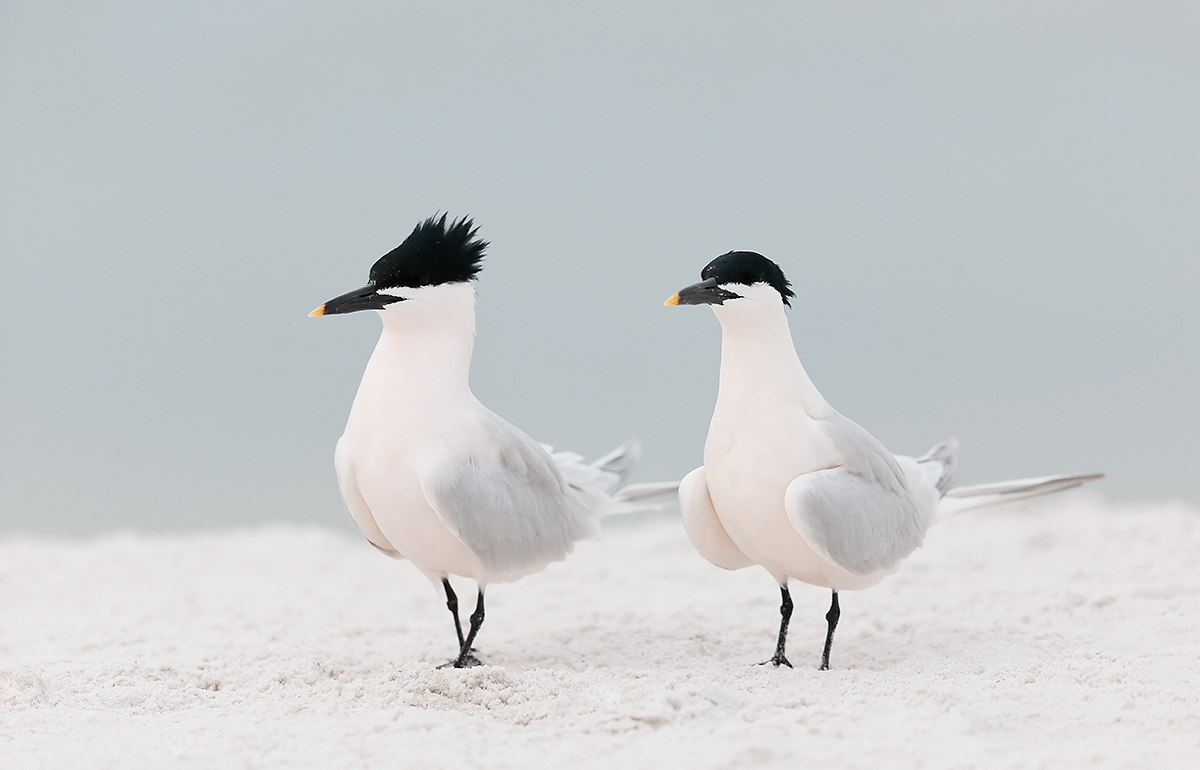
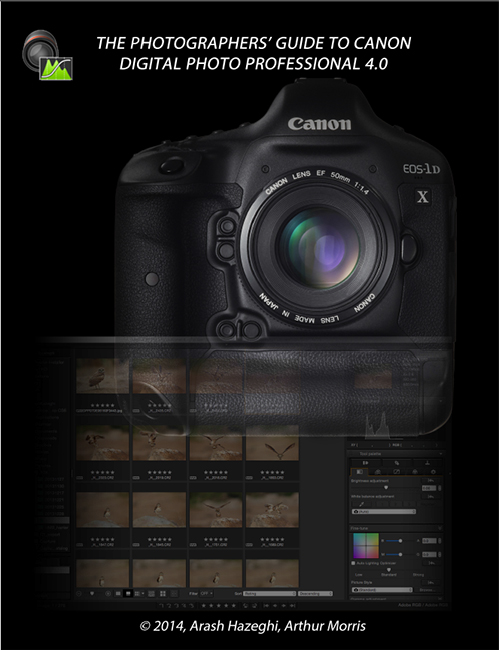
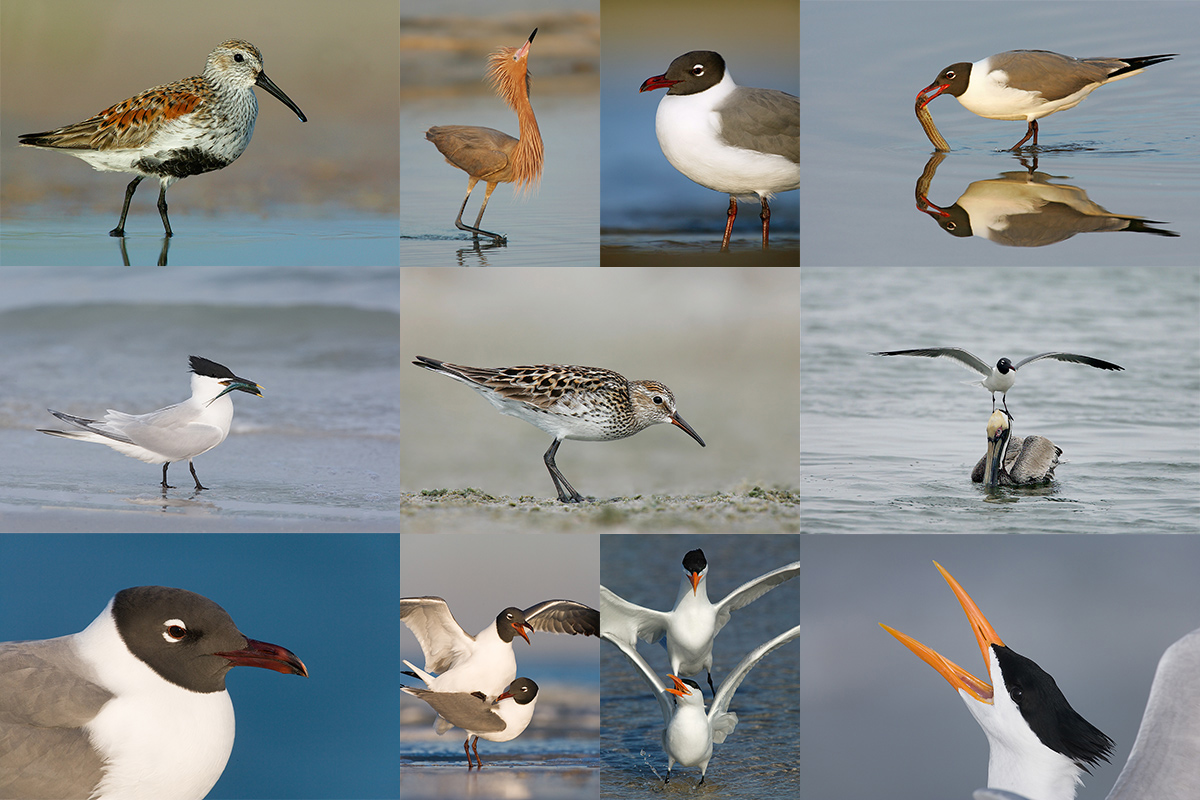
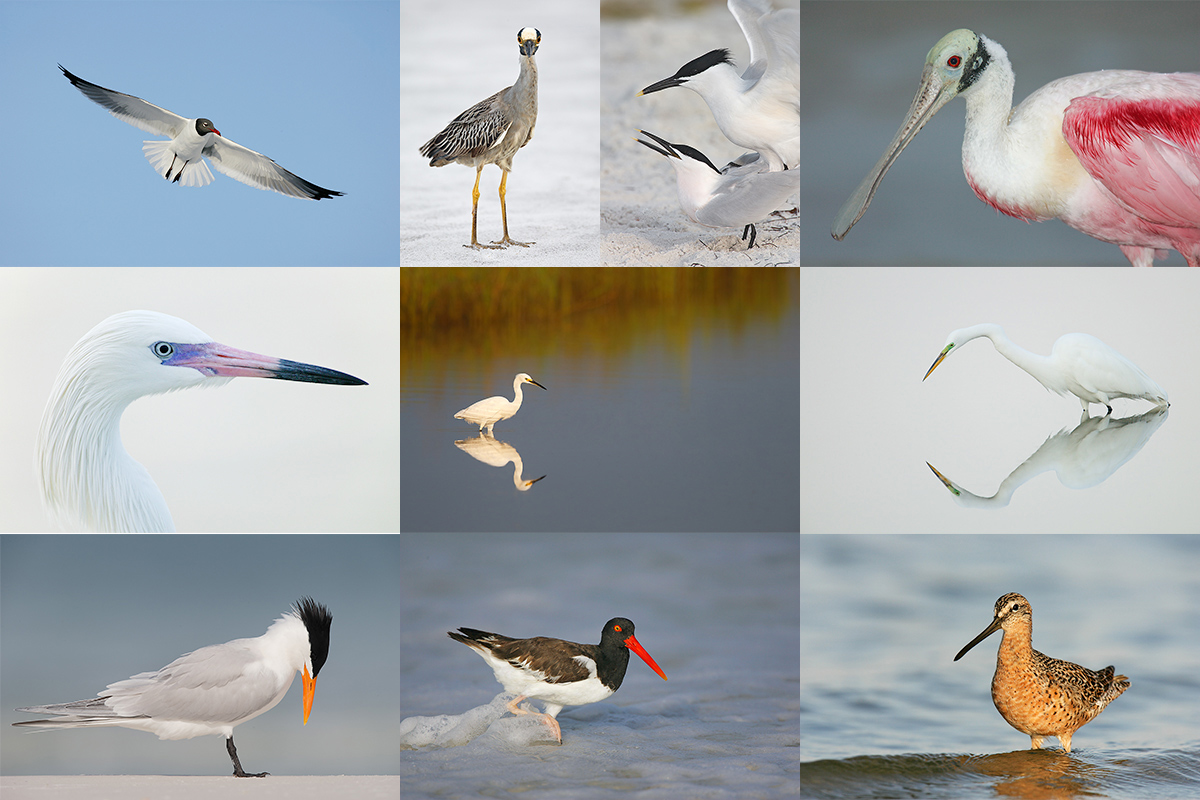













I wouldn’t bother cleaning up the sand unless there is a bunch of trash.
I agree with Craig. The birds are so wonderful and your cleanup really sets them off.
I’ll go with “just right.” With elimination of dark spots, even those out of focus, the optimized version is such a clean image (no distractions) that it powerfully draws attention to the subjects.
Agree with Jackie that the foot fix is good.
Just got back from Ft DeSoto and Sandwich and Royal Terns were very active and beginning to breed.Great flight shots with fish and males bringing fish to prospective mates.A lot of Black Skimmers Some Godwits,Spoonies and Oystercatchers at North Beach.
A great place for bird photography!!
I’d probably just cleanup by the bird’s foot. But what a handsome pair!
I think it’s just about perfect…
Great fix on the foot. I find that kind of repair tricky in trying to get the fix to look natural. Beautiful pair of birds. I was wondering about the pink tint….
For me it is a bit too much. I’d prefer something in between.
For me, I would say just about right. Any more, and the sand would look to perfect.